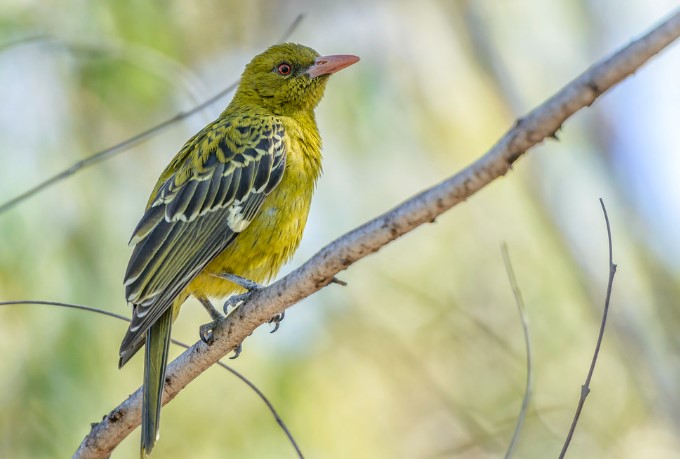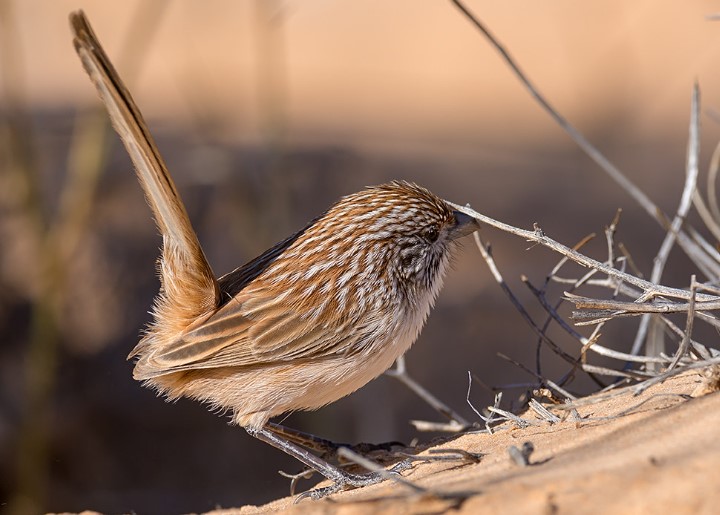The yellow Oriole belongs to the family Oriolidae. The bird is also known as the Yellow-bellied Oriole and Green Mulberry. The bubbling calls and echoes along the vine-forested streams of northern Australia in the hottest hours on most days. Although these birds are difficult to find, as their yellow-green plumage blends with the foliage only their profound bubbling melodic calls can be heard.
Though the Yellow Oriole is a sedentary bird, males sing sporadically throughout the day year-round to mark territory. One bird may call from a sheltered perch inside the tree canopy for up to two hours, almost non-stop. The call of Yellow Oriole is clear pee-kweek; harsh scarab in aggression. However, the song consists of rich, deep bubbling yok-yok-yoddle. The bird also sustained a sub-song of soft warblings. Apart from bursts of protracted singing, they are quiet birds and easily remain neither seen nor heard amid blending foliage. The size of a Yellow Oriole is about 270-280 mm in length, but males are larger.
Yellow Orioles are birds of rainforests and monsoon vine thickets, particularly those lining permanent, running streams. Solitary or in pairs, they feed almost exclusively on fruit in the middle and upper strata of the forest, keeping within the shelter of the canopy. They work slowly and methodically, feeding and sitting in one tree for more than a few hours or more before flying off to another 80-100 meters away in direct, deep undulations. The female undertakes most of the incubation and brooding, but both parents feed the young, mainly on fruit and by regurgitation.
After fledging, family groups remain together for a few weeks, and then the young are dispersed. In the months that follow they can wander rather widely, entering marginal habitats such as mangroves, paper-bark galleries, and gardens, and they often follow streams inland. At such times small groups of six or eight will gather with adults in profusely fruiting trees, particularly at the end of the dry season when resources are short.

The male bird’s general plumage is bright moss-green, yellower on the belly and undertail coverts; plumage is finely streaked black, from a few streaks on foreparts to more all over; mantle is always heavily marked with broad arrow-shaped streaks. Primaries black; secondaries and upper wing coverts black, edged and tipped with pale lemon-yellow to white; tail feathers black, edged with olive and tipped with lemon-yellow; central tail feathers browner than others. Their eyes are red. Bill is dull pink-red. The feet are dark grey. FEMALE: Similar to male but yellower and more streaked.
The immature bird upper parts are pale green, its underparts bright yellow, all coarsely streaked black. Yellow eyebrow contrasts with green streaked head. Wing and tail feathers are brown in color. Eyes are grey-brown. However, the bill is black to brown.
The nesting and breeding season occurs in October-March. The nest is cup-shaped, made of bark fiber, grass, dried leaves, and plant tendrils, bound with cobwebs; lined with finer plant material. The nest is usually fastened to a thin forked horizontal branch in the outer branchlets of trees, three to twenty meters above the ground.
Yellow Oriole lays 2 to 3 eggs, which are light cream to pale brown, variably blotched with dark brown and grey. The eggs are oblong-oval in shape, at the size of 34 x 23 mm. Incubation is mainly done by females.
As far as distribution, the Yellow Oriole is found in the coastal northern area of Australia and offshore islands from Sarina to Normanton, Queensland, and from Broome, Western Australia, to eastern Arnhem Land. This beautiful bird is also found in southern New Guinea and on Aru Islands.
There are six subspecies.
- f. flavocinctus – : Found in northern Australia
- f. migrator – Found in eastern Lesser Sundas
- f. kingi – Found in north-eastern Qld, (north-eastern Australia)
- f. tiwi – Found on Bathurst and Melville Islands (off northern Australia)
- f. flavotinctus – Found on Cape York Peninsula (north-eastern Australia)
- O. f. muelleri – Found in south-central New Guinea
Read More – Radiant Beauty of Bullock’s Oriole – North American Songbird

- The yellow Oriole (Oriolus flavocinctus) belongs to the family Oriolidae. The bird is also known as the Yellow-bellied Oriole and Green Mulberry.






